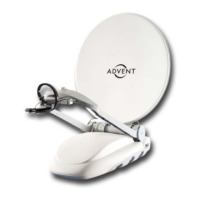VISLINK
Newswift 90-180 Motorised Antenna 20
4.14 AXIS POSITION AND STOWING CHECKS
As the system uses motor turn and pulse counting to calculate the angular position of the
antenna, any motor stall or freewheel can result in errors accumulating in the axis angle. The
softlimits act on these axis angles and are designed to stop the antenna from running into the
physical hard limits. If the angles are in error there is a danger of the antenna running into
the hard stops.
Further metal markers are used as travel limits to stop the antenna running into the physical
hard stops. The system uses the same Hall Effect detectors to monitor for these travel limits.
If detected, the system will stop any further antenna movement in that direction and warn the
user. The axis will also become uncalibrated.
The calibration markers are also used as stow position markers. On stowing, the system will
go to the stow position then check the size of the marker. If found and its size confirmed, the
system will stow. If no marker is detected the system will hunt ±10° for the marker. If not
found, or is the wrong size, a stowing failure will be declared.
4.15 SAFETY MICRO-SWITCH OPERATION AND FUNCTION
Two safety micro-switches are fitted to the Newswift Motorised System. One has a contact
closure when the antenna is in a physically stowed position. The other has a contact closure
when the antenna is physically in a position to transmit. For the Newswift Motorised System
this is just after the feed arm has been picked up on deployment.
These contact closure outputs are fed back to the controlling ACU via the COMMS cable. As
the signals are not controlled by the DCU electronics, these are available even if power to
the DCU fails. The outputs are available on the rear panel of the ACU. See ACU4XXX
manual for further details.
4.16 MANUAL BRAKE OVERRIDE OPERATION AND FUNCTION
If in the event of a failure in the ACU or DCU making remote control of the antenna
impossible, the antenna can be moved manually. The manual brake override switch (See
section 4.3) can be used to release the brakes on either the azimuth or elevation axis. This
requires the presence of the 12V DC supply to the DCU.
If the manual brake override is not put back to its off position, the system will not control the
antenna remotely. An alarm will be relayed to the controlling ACU.
If the antenna is manually moved when the manual brake override is used the DCU position
data will be incorrect. If the system is then switched back to automatic mode the soft and
wooded area limits will not operate at the correct antenna positions.
It is recommended that if the manual brake override is used then before automatic control
can be used again the following procedure is carried out.
The antenna is manually positioned in its’ stow position then a DCU software reset is carried
out. A software reset can either be done by using the ACS3000 software, see manual
207173 section 3.11, reset variables. Or whilst pushing the software button, SW1 on the
bottom DCU PCB, press and release the reset button SW3. The LED will flash three times
indicating a software reset has taken place.

